Pathways for Cleaner, Greener, Healthier Cities: What Is the Role of Urban Agriculture in the Circular Economy of Two Nordic Cities?
Abstract
1. Introduction
- What are the barriers that impact the successful implementation of C-E practices in the context of UA?
- How are those barriers challenging cities in transitioning from linear, industrial agri-food systems to more circular and sustainable food production models? And how have innovative solutions been facilitating this transition?
2. Literature Review
2.1. Cities and the Role of Urban Agriculture
2.2. Circular Economy and Its Strategies at an Urban Level
2.3. From a Linear to Circular Urban Agriculture
3. Methods
3.1. Case Study Identification and Data Collection
3.2. Analysis
4. Results
4.1. Campus Ås
4.2. Taste Aarhus
4.3. Analysing Barriers That Influence the Successful Implementation of Circular Economy Practices in the Context of Urban Agriculture
4.3.1. Technic and Technological Barriers
4.3.2. Market and Financial Barriers
“Fællesgartneriet [is] fighting right now against the municipality and the new plans for our land. (…) The possibilities in large-scale urban farming and peri-urban farming are sadly unknown to the planners in Aarhus; they want us [the gardens] to move out soon and stop what we are doing [in the gardens]”
4.3.3. Social and Cultural Barriers
4.3.4. Regulatory and Institutional Barriers: Governance for a More Circular Urban Agriculture
5. Discussion
6. Conclusions
Supplementary Materials
Author Contributions
Funding
Data Availability Statement
Acknowledgments
Conflicts of Interest
References
- Paiho, S.; Mäki, E.; Wessberg, N.; Paavola, M.; Tuominen, P.; Antikainen, M.; Heikkilä, J.; Rozado, C.A.; Jung, N. Towards Circular Cities—Conceptualizing Core Aspects. Sustain. Cities Soc. 2020, 59, 102143. [Google Scholar] [CrossRef]
- United Nations UN. DESA News. Available online: https://www.un.org/development/desa/en/news/population/2018-revision-of-world-urbanization-prospects.html (accessed on 26 October 2022).
- IRP. The Weight of Cities: Resource Requirements of Future Urbanization; Report by the International Resource Panel; United Nations Environment Programme: Nairobi, Kenya, 2018. [Google Scholar]
- Kaufmann, L.; Mayer, A.; Matej, S.; Kalt, G.; Lauk, C.; Theurl, M.C.; Erb, K.-H. Regional Self-Sufficiency: A Multi-Dimensional Analysis Relating Agricultural Production and Consumption in the European Union. Sustain. Prod. Consum. 2022, 34, 12–25. [Google Scholar] [CrossRef]
- Pascucci, S. Building Natural Resource Networks: Urban Agriculture and the Circular Economy. In Achieving Sustainable Urban Agriculture; Burleigh Dodds Science Publishing: London, UK, 2020; pp. 101–120. [Google Scholar] [CrossRef]
- Dantas, T.E.T.; de-Souza, E.D.; Destro, I.R.; Hammes, G.; Rodriguez, C.M.T.; Soares, S.R. How the Combination of Circular Economy and Industry 4.0 Can Contribute towards Achieving the Sustainable Development Goals. Sustain. Prod. Consum. 2021, 26, 213–227. [Google Scholar] [CrossRef]
- Garcia-Saravia Ortiz-de-Montellano, C.; Samani, P.; van der Meer, Y. How Can the Circular Economy Support the Advancement of the Sustainable Development Goals (SDGs)? A Comprehensive Analysis. Sustain. Prod. Consum. 2023, 40, 352–362. [Google Scholar] [CrossRef]
- Davies, J.; Hannah, C.; Guido, Z.; Zimmer, A.; McCann, L.; Battersby, J.; Evans, T. Barriers to Urban Agriculture in Sub-Saharan Africa. Food Policy 2021, 103, 101999. [Google Scholar] [CrossRef]
- Pradhan, P.; Callaghan, M.; Hu, Y.; Dahal, K.; Hunecke, C.; Reusswig, F.; Lotze-Campen, H.; Kropp, J.P. A Systematic Review Highlights That There Are Multiple Benefits of Urban Agriculture besides Food. Glob. Food Secur. 2023, 38, 100700. [Google Scholar] [CrossRef]
- Abdoellah, O.S.; Suparman, Y.; Safitri, K.I.; Mubarak, A.Z.; Milani, M.; Margareth; Surya, L. Between Food Fulfillment and Income: Can Urban Agriculture Contribute to Both? Geogr. Sustain. 2023, 4, 127–137. [Google Scholar] [CrossRef]
- Menconi, M.E.; Borghi, P.; Grohmann, D. Urban Agriculture, Cui Prodest? Seattle’s Picardo Farm as Seen by Its Gardeners. Lect. Notes Civ. Eng. 2020, 67, 163–168. [Google Scholar] [CrossRef]
- Brown, S.; Butman, D.; Kurtz, K. Steps to Circularity: Impact of Resource Recovery and Urban Agriculture in Seattle and Tacoma, Washington. J. Environ. Manag. 2023, 345, 118648. [Google Scholar] [CrossRef]
- International Resource Panel. Urban Agriculture’s Potential to Advance Multiple Sustainability Goals: An International Resource Panel Think Piece; Ayuk, E.T., Ramaswami, A., Teixeira, I., Akpalu, W., Eckart, E., Ferreira, J., Kirti, D., de Souza Leao, V., Eds.; A Think Piece of the International Resource Panel; Nairobi: United Nations Environment Programme: Nairobi, Kenya, 2021; Available online: https://www.unep.org/resources/publication/urban-agricultures-potential-advance-multiple-sustainability-goals (accessed on 23 September 2023).
- Dalla Marta, A.; Baldi, A.; Lenzi, A.; Lupia, F.; Pulighe, G.; Santini, E.; Orlandini, S.; Altobelli, F. A Methodological Approach for Assessing the Impact of Urban Agriculture on Water Resources: A Case Study for Community Gardens in Rome (Italy). Agroecol. Sustain. Food Syst. 2019, 43, 228–240. [Google Scholar] [CrossRef]
- Harada, Y.; Whitlow, T.H.; Templer, P.H.; Howarth, R.W.; Todd Walter, M.; Bassuk, N.L.; Russell-Anelli, J. Nitrogen Biogeochemistry of an Urban Rooftop Farm. Front. Ecol. Evol. 2018, 6, 153. [Google Scholar] [CrossRef]
- De Jesus, A.; Antunes, P.; Santos, R.; Mendonça, S. Eco-Innovation Pathways to a Circular Economy: Envisioning Priorities through a Delphi Approach. J. Clean. Prod. 2019, 228, 1494–1513. [Google Scholar] [CrossRef]
- De Jesus, A.; Antunes, P.; Santos, R.; Mendonça, S. Eco-Innovation in the Transition to a Circular Economy: An Analytical Literature Review. J. Clean. Prod. 2018, 172, 2999–3018. [Google Scholar] [CrossRef]
- Coskun, A.; Metta, J.; Bakırlıoğlu, Y.; Çay, D.; Bachus, K. Make It a Circular City: Experiences and Challenges from European Cities Striving for Sustainability through Promoting Circular Making. Resour. Conserv. Recycl. 2022, 185, 106495. [Google Scholar] [CrossRef]
- Flyvbjerg, B. Five Misunderstandings About Case-Study Research. Qual. Inq. 2006, 12, 219–245. [Google Scholar] [CrossRef]
- Patton, M.Q. Sampling, Qualitative (Purposeful). The Blackwell Encyclopedia of Sociology. 2015. Available online: https://onlinelibrary.wiley.com/doi/abs/10.1002/9781405165518.wbeoss012.pub2 (accessed on 23 September 2023).
- Borges, L.A.; Nilsson, K.; Tunström, M.; Dis, A.T.; Perjo, L.; Berlina, A.; Costa, S.O.; Fredricsson, C.; Grunfelder, J.; Johnsen, I.; et al. White Paper on Nordic Sustainable Cities; Nordregio: Stockholm, Sweden, 2017. [Google Scholar]
- Johnson, O.W. Learning from Nordic Cities on Climate Action. One Earth 2020, 2, 128–131. [Google Scholar] [CrossRef]
- Quitzau, M.-B.; Gustafsson, S.; Hoffmann, B.; Krantz, V. Sustainability Coordination within Forerunning Nordic Municipalities—Exploring Structural Challenges across Departmental Silos and Hierarchies. J. Clean. Prod. 2022, 335, 130330. [Google Scholar] [CrossRef]
- Schrage, J. Three Tensions in Governing Energy Demand: A Social Practice Perspective on Nordic Urban Interventions. Cities 2023, 141, 104497. [Google Scholar] [CrossRef]
- D’Ostuni, M.; Zaffi, L. Nurturing Cities: Pathways towards a Circular Urban Agriculture. In Proceedings of the World Heritage and Desing for Health XIX International Forum, Naples/Capri, Italy, 12 August 2021. [Google Scholar]
- Royer, H.; Yengue, J.L.; Bech, N. Urban Agriculture and Its Biodiversity: What Is It and What Lives in It? Agric. Ecosyst. Environ. 2023, 346, 108342. [Google Scholar] [CrossRef]
- Borges, L.A.; Berlina, A.; Wang, S. Baseline Study Including Key Indicators and Development of a Typology, Deliverable D1.2, (Sino-European Innovative Green and Smart Cities). 2019. Available online: https://cordis.europa.eu/project/id/774233/results (accessed on 23 September 2023).
- DRAXIS. Market Analysis III, Deliverable D5.3, Sino-European Innovative Green and Smart Cities. 2021. Available online: https://cordis.europa.eu/project/id/774233/results (accessed on 23 September 2023).
- Langemeyer, J.; Madrid-Lopez, C.; Beltran, A.M.; Mendez, G.V. Urban Agriculture—A Necessary Pathway towards Urban Resilience and Global Sustainability? Landsc. Urban Plan. 2021, 210, 104055. [Google Scholar] [CrossRef]
- Armanda, D.T.; Guinée, J.B.; Tukker, A. The Second Green Revolution: Innovative Urban Agriculture’s Contribution to Food Security and Sustainability—A Review. Glob. Food Secur. 2019, 22, 13–24. [Google Scholar] [CrossRef]
- Bennedetti, L.V.; de Almeida Sinisgalli, P.A.; Ferreira, M.L.; Lemes de Oliveira, F. Challenges to Promote Sustainability in Urban Agriculture Models: A Review. Int. J. Environ. Res. Public Health 2023, 20, 2110. [Google Scholar] [CrossRef] [PubMed]
- Poulsen, M.N.; McNab, P.R.; Clayton, M.L.; Neff, R.A. A Systematic Review of Urban Agriculture and Food Security Impacts in Low-Income Countries. Food Policy 2015, 55, 131–146. [Google Scholar] [CrossRef]
- Gulyas, B.Z.; Edmondson, J.L. Increasing City Resilience through Urban Agriculture: Challenges and Solutions in the Global North. Sustainability 2021, 13, 1465. [Google Scholar] [CrossRef]
- Nadal, A.; Pons, O.; Cuerva, E.; Rieradevall, J.; Josa, A. Rooftop Greenhouses in Educational Centers: A Sustainability Assessment of Urban Agriculture in Compact Cities. Sci. Total Environ. 2018, 626, 1319–1331. [Google Scholar] [CrossRef] [PubMed]
- Ferreira, A.J.D.; Guilherme, R.I.M.M.; Ferreira, C.S.S.; de Fatima Martins Lorena de Oliveira, M. Urban Agriculture, a Tool towards More Resilient Urban Communities? Curr. Opin. Environ. Sci. Health 2018, 5, 93–97. [Google Scholar] [CrossRef]
- Rao, N.; Patil, S.; Singh, C.; Roy, P.; Pryor, C.; Poonacha, P.; Genes, M. Cultivating Sustainable and Healthy Cities: A Systematic Literature Review of the Outcomes of Urban and Peri-Urban Agriculture. Sustain. Cities Soc. 2022, 85, 104063. [Google Scholar] [CrossRef]
- Skar, S.L.G.; Pineda-Martos, R.; Timpe, A.; Pölling, B.; Bohn, K.; Külvik, M.; Delgado, C.; Pedras, C.M.G.; Paço, T.A.; Ćujić, M.; et al. Urban Agriculture as a Keystone Contribution towards Securing Sustainable and Healthy Development for Cities in the Future. Blue-Green Syst. 2019, 2, 1–27. [Google Scholar] [CrossRef]
- Kirchherr, J.; Reike, D.; Hekkert, M. Conceptualizing the Circular Economy: An Analysis of 114 Definitions. Resour. Conserv. Recycl. 2017, 127, 221–232. [Google Scholar] [CrossRef]
- Kirchherr, J.; Yang, N.-H.N.; Schulze-Spüntrup, F.; Heerink, M.J.; Hartley, K. Conceptualizing the Circular Economy (Revisited): An Analysis of 221 Definitions. Resour. Conserv. Recycl. 2023, 194, 107001. [Google Scholar] [CrossRef]
- Hobson, K.; Lynch, N. Diversifying and De-Growing the Circular Economy: Radical Social Transformation in a Resource-Scarce World. Futures 2016, 82, 15–25. [Google Scholar] [CrossRef]
- Skene, K.R. The Circular Economy: A Critique of the Concept. In Towards a Circular Economy: Transdisciplinary Approach for Business; Alvarez-Risco, A., Rosen, M.A., Del-Aguila-Arcentales, S., Eds.; CSR, Sustainability, Ethics & Governance; Springer International Publishing: Cham, Switzerland, 2022; pp. 99–116. ISBN 978-3-030-94293-9. [Google Scholar]
- Skene, K.R. Circles, Spirals, Pyramids and Cubes: Why the Circular Economy Cannot Work. Sustain. Sci. 2017, 13, 479–492. [Google Scholar] [CrossRef]
- Korhonen, J.; Nuur, C.; Feldmann, A.; Birkie, S.E. Circular Economy as an Essentially Contested Concept. J. Clean. Prod. 2018, 175, 544–552. [Google Scholar] [CrossRef]
- EC Circular Economy Action Plan. Available online: https://environment.ec.europa.eu/strategy/circular-economy-action-plan_en (accessed on 23 September 2023).
- Pinyol Alberich, J.; Pansera, M.; Hartley, S. Understanding the EU’s Circular Economy Policies through Futures of Circularity. J. Clean. Prod. 2023, 385, 135723. [Google Scholar] [CrossRef]
- Christis, M.; Athanassiadis, A.; Vercalsteren, A. Implementation at a City Level of Circular Economy Strategies and Climate Change Mitigation—The Case of Brussels. J. Clean. Prod. 2019, 218, 511–520. [Google Scholar] [CrossRef]
- EMF. Delivering the Circular Economy—A Toolkit for Policymakers; Denmark Case Study; Ellen MacArthur Foundation (EMF): Isle of Wight, UK, 2016. [Google Scholar]
- State of Green. Denmark as a Circular Economy Solution Hub; Confederation of Danish Industry: Copenhagen, Denmark, 2016. [Google Scholar]
- Reike, D.; Vermeulen, W.J.V.; Witjes, S. The Circular Economy: New or Refurbished as CE 3.0?—Exploring Controversies in the Conceptualization of the Circular Economy through a Focus on History and Resource Value Retention Options. Resour. Conserv. Recycl. 2018, 135, 246–264. [Google Scholar] [CrossRef]
- Schmitz, H.; Altenburg, T. Innovation Paths in Europe and Asia: Divergence or Convergence? Sci. Public Policy 2016, 43, 454–463. [Google Scholar] [CrossRef]
- Van Berkel, R.; Fujita, T.; Hashimoto, S.; Geng, Y. Industrial and Urban Symbiosis in Japan: Analysis of the Eco-Town Program 1997–2006. J. Environ. Manag. 2009, 90, 1544–1556. [Google Scholar] [CrossRef]
- EMF. A Circular Economy in Brazil: An Initial Exploration; Ellen MacArthur Foundation (EMF): Isle of Wight, UK, 2017. [Google Scholar]
- EMF. Circular Economy in India: Rethinking Growth for Long-Term Prosperity; Ellen MacArthur Foundation (EMF): Isle of Wight, UK, 2016. [Google Scholar]
- Mativenga, P.T.; Sultan, A.A.M.; Agwa-Ejon, J.; Mbohwa, C. Composites in a Circular Economy: A Study of United Kingdom and South Africa. Procedia CIRP 2017, 61, 691–696. [Google Scholar] [CrossRef]
- Manríquez-Altamirano, A.; Sierra-Pérez, J.; Muñoz, P.; Gabarrell, X. Identifying Potential Applications for Residual Biomass from Urban Agriculture through Eco-Ideation: Tomato Stems from Rooftop Greenhouses. J. Clean. Prod. 2021, 295, 126360. [Google Scholar] [CrossRef]
- Bortolotti, A.; Verga, G.C.; Khan, A.Z. Which Circularity for Urban Design and Planning? A Compass to Navigate Circular Economy Research Knowledge and Methods. Plan. Pract. Res. 2023. [Google Scholar] [CrossRef]
- Bote Alonso, I.; Sánchez-Rivero, M.V.; Montalbán Pozas, B. Mapping Sustainability and Circular Economy in Cities: Methodological Framework from Europe to the Spanish Case. J. Clean. Prod. 2022, 357, 131870. [Google Scholar] [CrossRef]
- Prendeville, S.; Cherim, E.; Bocken, N. Circular Cities: Mapping Six Cities in Transition. Environ. Innov. Soc. Transit. 2018, 26, 171–194. [Google Scholar] [CrossRef]
- Ziskind, J.; Guna, D. Circular Economy in Cities Evolving the Model for a Sustainable Urban Future; White Paper World Economic Forum Cologny: Geneva, Switzerland, 2018. [Google Scholar]
- Lakatos, E.S.; Yong, G.; Szilagyi, A.; Clinci, D.S.; Georgescu, L.; Iticescu, C.; Cioca, L.-I. Conceptualizing Core Aspects on Circular Economy in Cities. Sustainability 2021, 13, 7549. [Google Scholar] [CrossRef]
- Riaño-Herrera, D.A.; Romero-Perdomo, F.A.; Rodriguez-Urrego, L. Advances and Challenges Between Urban Agriculture and the Circular Economy to Promote Sustainable Cities. In Proceedings of the 2023 IEEE Colombian Conference on Communications and Computing (COLCOM), Bogotá, Colombia, 26 July 2023; pp. 1–6. [Google Scholar]
- Artmann, M.; Sartison, K. The Role of Urban Agriculture as a Nature-Based Solution: A Review for Developing a Systemic Assessment Framework. Sustainability 2018, 10, 1937. [Google Scholar] [CrossRef]
- Ddiba, D.; Ekener, E.; Lindkvist, M.; Finnveden, G. Sustainability Assessment of Increased Circularity of Urban Organic Waste Streams. Sustain. Prod. Consum. 2022, 34, 114–129. [Google Scholar] [CrossRef]
- Thomaier, S.; Specht, K.; Henckel, D.; Dierich, A.; Siebert, R.; Freisinger, U.; Sawicka, M. Farming in and on Urban Buildings: Present Practice and Specific Novelties of Zero-Acreage Farming (ZFarming). Renew. Agric. Food Syst. 2014, 30, 43–54. [Google Scholar] [CrossRef]
- Javan, K.; Altaee, A.; BaniHashemi, S.; Darestani, M.; Zhou, J.; Pignatta, G. A Review of Interconnected Challenges in the Water–Energy–Food Nexus: Urban Pollution Perspective towards Sustainable Development. Sci. Total Environ. 2024, 912, 169319. [Google Scholar] [CrossRef]
- Simon, S. The Role of Design Thinking to Promote a Sustainability Transition within Participatory Urban Governance: Insights from Urban Agriculture Initiatives in Lisbon. Urban Gov. 2023, 3, 189–199. [Google Scholar] [CrossRef]
- Fernandez Andres, J. Can Urban Agriculture Become a Planning Strategy to Address Social-Ecological Justice? KTH Royal Institute of Technology: Stockholm, Sweden, 2017. [Google Scholar]
- Horst, M.; McClintock, N.; Hoey, L. The Intersection of Planning, Urban Agriculture, and Food Justice: A Review of the Literature. J. Am. Plan. Assoc. 2017, 83, 277–295. [Google Scholar] [CrossRef]
- Lee, T.-I.; Chou, Y.-H.; Huang, T.-N. Users’ Perceptions and Attitudes towards Edible Campus. Int. J. Des. Nat. Ecodyn. 2019, 14, 30–40. [Google Scholar] [CrossRef]
- Sbicca, J. Urban Agriculture, Revalorization, and GreenGentrification in Denver, Colorado. Politics Land 2019, 26, 149–170. [Google Scholar] [CrossRef]
- Schröder, P. Promoting a Just Transition to an Inclusive Circular Economy; Environment and Resources Programme Research Paper; Chatham House: Oslo, Norway, 2020. [Google Scholar]
- Yin, R.K. Case Study Research: Design and Methods; SAGE: Thousand Oaks, CA, USA, 2009; ISBN 978-1-4129-6099-1. [Google Scholar]
- Cassell, C.; Symon, G.; Symon, D.G. Essential Guide to Qualitative Methods in Organizational Research; SAGE Publications: Thousand Oaks, CA, USA, 2004; ISBN 978-0-7619-4888-9. [Google Scholar]
- Berg, B.L. Qualitative Research Methods for the Social Sciences; Allyn and Bacon: Boston, MA, USA, 2001; ISBN 978-0-205-31847-6. [Google Scholar]
- SiEUGreen. Sino-European Innovative Green and Smart Cities. Available online: https://cordis.europa.eu/project/id/774233/results (accessed on 6 October 2023).
- De Jesus, A.; Mendonça, S. Lost in Transition? Drivers and Barriers in the Eco-Innovation Road to the Circular Economy. Ecol. Econ. 2017, 145, 75–89. [Google Scholar] [CrossRef]
- Auld, G.W.; Diker, A.; Bock, M.A.; Boushey, C.J.; Bruhn, C.M.; Cluskey, M.; Edlefsen, M.; Goldberg, D.L.; Misner, S.L.; Olson, B.H.; et al. Development of a Decision Tree to Determine Appropriateness of NVivo in Analyzing Qualitative Data Sets. J. Nutr. Educ. Behav. 2007, 39, 37–47. [Google Scholar] [CrossRef]
- Citypopulation Ås (Municipality, Viken, Norway)—Population Statistics, Charts, Map and Location. Available online: https://citypopulation.de (accessed on 5 October 2023).
- Borges, L.A.; Rohrer, L. Engagement Strategies II; Deliverable D1.6. (Sino-European Innovative Green and Smart Cities). 2022. Available online: https://cordis.europa.eu/project/id/774233/results (accessed on 23 September 2023).
- Hansen, R.; Buizer, M.; Rall, E.; DeBellis, Y.; Elands, B.H.; Wiersum, F.; Pauleit, S. Report of Case Study City Portraits: Appendix—Green Surge Study on Urban Green Infrastructure Planning and Governance in 20 European Case Studies; Project Green Surge, EU FP7; Wageningen University and Research: Wageningen, The Netherlands, 2015. [Google Scholar]
- Borges, L.A.; Randall, L.; Wang, S. Maps of Quantitative and Qualitative Data for Each of the Showcase Locations: Synthesis Report, Deliverable D1.1. (Sino-European Innovative Green and Smart Cities). 2018. Available online: https://cordis.europa.eu/project/id/774233/results (accessed on 23 September 2023).
- Zamparas, M. The Role of Resource Recovery Technologies in Reducing the Demand of Fossil Fuels and Conventional Fossil-Based Mineral Fertilizers. In Low Carbon Energy Technologies in Sustainable Energy Systems; Academic Press: Cambridge, MA, USA, 2021; pp. 3–24. ISBN 978-0-12-822897-5. [Google Scholar]
- World Bank. Water Supply and Sanitation Policies, Institutions, and Regulation: Adapting to a Changing World; World Bank Group: Washington, DC, USA, 2022. [Google Scholar]
- Lahlou, F.-Z.; AlNouss, A.; Govindan, R.; Hazrat, B.; Mackey, H.R.; Al-Ansari, T. Water and Sludge Resource Planning for Sustainable Agriculture: An Energy-Water-Food-Waste Nexus Approach. Sustain. Prod. Consum. 2023, 38, 130–148. [Google Scholar] [CrossRef]
- Despommier, D.D. The Vertical Farm: Feeding the World in the 21st Century, 1st ed.; A Thomas Dunne Book; Picador: New York, NY, USA, 2010; ISBN 978-1-250-76980-0. Available online: https://www.google.se/books/edition/The_Vertical_Farm/0DxTK0jW35sC?hl=en&gbpv=1&dq=The+Vertical+Farm:+Feeding+the+World+in+the+21st+Century&printsec=frontcover (accessed on 8 October 2023).
- Chrebet, T.; Martinka, J. Assessment of Biogas Potential Hazards. Annals of the Faculty of Engineering Hunedoara. Int. J. Eng. 2012, 10, 39. [Google Scholar]
- Salvi, O.; Chaubet, C.; Evanno, S. Improving the Safety of Biogas Production in Europe. Rev. Ing. 2012, 37, 57–65. [Google Scholar] [CrossRef]
- Poortvliet, P.M.; Sanders, L.; Weijma, J.; De Vries, J.R. Acceptance of New Sanitation: The Role of End-Users’ pro-Environmental Personal Norms and Risk and Benefit Perceptions. Water Res. 2018, 131, 90–99. [Google Scholar] [CrossRef]
- SiEUGreen. Circular Drainage Solution: From Poop to Super Fertiliser; SiEUGreen—Sino-European Innovative Green and Smart Cities. Available online: https://www.youtube.com/watch?v=BMrIzDbPzF0 (accessed on 8 October 2023).
- SiEUGreen. The Development of Aarhus Showcase; SiEUGreen—Sino-European Innovative Green and Smart Cities: Aarhus, Denmark, 2021; Available online: https://www.youtube.com/watch?v=DqRlywkPL2E (accessed on 8 October 2023).
- Market Watch. Urban Farming Market Application, Product, Sales and Forecast 2022–2030 Report; MarketWatch: New York, NY, USA, 2022. [Google Scholar]
- ScanWater. GREENERGY Technology. Available online: https://scanwater.no/our-solutions/water-solutions/aqa-greenergy-technology/ (accessed on 19 September 2023).
- Papari, C.-A.; Toxopeus, H.; Polzin, F.; Bulkeley, H.; Menguzzo, E.V. Can the EU Taxonomy for Sustainable Activities Help Upscale Investments into Urban Nature-Based Solutions? Environ. Sci. Policy 2024, 151, 103598. [Google Scholar] [CrossRef]
- Cong, R.-G.; Thomsen, M. Review of Ecosystem Services in a Bio-Based Circular Economy and Governance Mechanisms. Ecosyst. Serv. 2021, 50, 101298. [Google Scholar] [CrossRef]
- Shao, Y.; Zhou, Z.; Chen, H.; Zhang, F.; Cui, Y.; Zhou, Z. The Potential of Urban Family Vertical Farming: A Pilot Study of Shanghai. Sustain. Prod. Consum. 2022, 34, 586–599. [Google Scholar] [CrossRef]
- Hallett, S.; Hoagland, L.; Toner, E. Urban Agriculture: Environmental, Economic, and Social Perspectives. In Horticultural Reviews; John Wiley & Sons, Ltd.: Hoboken, NJ, USA, 2016; Volume 44, pp. 65–120. ISBN 978-1-119-28126-9. [Google Scholar]
- Dagevos, H.; de Lauwere, C. Circular Business Models and Circular Agriculture: Perceptions and Practices of Dutch Farmers. Sustainability 2021, 13, 1282. [Google Scholar] [CrossRef]
- Donner, M.; Gohier, R.; de Vries, H. A New Circular Business Model Typology for Creating Value from Agro-Waste. Sci. Total Environ. 2020, 716, 137065. [Google Scholar] [CrossRef] [PubMed]
- Davidson, D. Is Urban Agriculture a Game Changer or Window Dressing? A Critical Analysis of Its Potential to Disrupt Conventional Agri-Food Systems. Int. J. Sociol. Agric. Food 2017, 23, 63–76. [Google Scholar] [CrossRef]
- Marini, M.; Caro, D.; Thomsen, M. Investigating Local Policy Instruments for Different Types of Urban Agriculture in Four European Cities: A Case Study Analysis on the Use and Effectiveness of the Applied Policy Instruments. Land Use Policy 2023, 131, 106695. [Google Scholar] [CrossRef]
- Bannor, R.K.; Oppong-Kyeremeh, H.; Kyire, S.K.C.; Aryee, H.N.A.; Amponsah, H. Market Participation of Urban Agriculture Producers and Its Impact on Poverty: Evidence from Ghana. Sustain. Futures 2022, 4, 100099. [Google Scholar] [CrossRef]
- Corcoran, M.P.; Kettle, P.C. Urban Agriculture, Civil Interfaces and Moving beyond Difference: The Experiences of Plot Holders in Dublin and Belfast. Local Environ. 2015, 20, 1215–1230. [Google Scholar] [CrossRef]
- Hovorka, A. Urban Agriculture: Addressing Practical and Strategic Gender Needs. Dev. Pract. 2006, 16, 51–61. [Google Scholar] [CrossRef]
- Barthel, S.; Folke, C.; Colding, J. Social–Ecological Memory in Urban Gardens—Retaining the Capacity for Management of Ecosystem Services. Glob. Environ. Chang. 2010, 20, 255–265. [Google Scholar] [CrossRef]
- Shostak, S.; Guscott, N. “Grounded in the Neighborhood, Grounded in Community”: Social Capital and Health in Community Gardens. Adv. Med. Sociol. 2017, 18, 199–222. [Google Scholar] [CrossRef]
- Dogan, E.; Cuomo, F.; Battisti, L. Reviving Urban Greening in Post-Industrial Landscapes: The Case of Turin. Sustainability 2023, 15, 12760. [Google Scholar] [CrossRef]
- Brown, K.H.; Jameton, A.L. Public Health Implications of Urban Agriculture. J. Public Health Policy 2000, 21, 20. [Google Scholar] [CrossRef] [PubMed]
- Egerer, M.; Lin, B.; Kingsley, J.; Marsh, P.; Diekmann, L.; Ossola, A. Gardening Can Relieve Human Stress and Boost Nature Connection during the COVID-19 Pandemic. Urban For. Urban Green. 2022, 68, 127483. [Google Scholar] [CrossRef] [PubMed]
- Tapia, C.; Borges, L.A.; Wang, S.; Randall, L. Guidelines for a New Interactive Impact Assessment Approaches, Deliverable D1.4. (Sino-European Innovative Green and Smart Cities). 2020. Available online: https://cordis.europa.eu/project/id/774233/results (accessed on 23 September 2023).
- Zeunert, J. Dimensions of Urban Agriculture. In Routledge Handbook of Landscape and Food; Zeunert, J., Waterman, T., Eds.; Routledge: London, UK, 2020. [Google Scholar]
- Antić, I.; Škrbić, B.D.; Matamoros, V.; Bayona, J.M. Does the Application of Human Waste as a Fertilization Material in Agricultural Production Pose Adverse Effects on Human Health Attributable to Contaminants of Emerging Concern? Environ. Res. 2020, 182, 109132. [Google Scholar] [CrossRef] [PubMed]
- Bhatti, A.K. An Explorative Study on Norwegian Users’ Understandings and Practices of Vacuum Toilet Systems in Private and Semi-Private Residences. Master’s Thesis, University of Oslo, Oslo, Norway, 2021. [Google Scholar]
- Mæhlum, T.; Føreid; Moges, M.E.; Hvoslef-Eide, T.; Jenssen, P.; Pandey, M.K. Qualitative and Quantitative Assessment for Nutrients and Energy, Deliverable D2.5. (Sino-European Innovative Green and Smart Cities). 2022. Available online: https://cordis.europa.eu/project/id/774233/results (accessed on 23 September 2023).
- Dagilienė, L.; Varaniūtė, V.; Bruneckienė, J. Local Governments’ Perspective on Implementing the Circular Economy: A Framework for Future Solutions. J. Clean. Prod. 2021, 310, 127340. [Google Scholar] [CrossRef]
- Safransky, S. Greening the Urban Frontier: Race, Property, and Resettlement in Detroit. Geoforum 2014, 56, 237–248. [Google Scholar] [CrossRef]
- Landbruksdepartementet Forskrift om Gjødselvarer m.v. av Organisk Opphav. Available online: https://www.regjeringen.no/no/dokumenter/forskrift-om--gjodselvarer-mv-av-organis/id92312/ (accessed on 2 August 2023).
- Regjeringen Organic Fertilising Products. Available online: https://www.regjeringen.no/en/topics/business-and-industry/product-contact-point/norwegian-technical-rules/agriculture-fishing-and-foodstuffs/organic-fertilising-products/id2788888/ (accessed on 7 August 2023).
- Aarhus Municipality Vision, Mål Og Indsatsområder 2018. Available online: https://aarhus.dk/om-kommunen/borgmesterens-afdeling/vision-maal-og-indsatsomraader/ (accessed on 7 November 2023).
- Wolfram, M.; Borgström, S.; Farrelly, M. Urban Transformative Capacity: From Concept to Practice. Ambio 2019, 48, 437–448. [Google Scholar] [CrossRef] [PubMed]
- Potting, J.; Hekkert, M.P.; Worrell, E.; Hanemaaijer, A. Circular Economy: Measuring Innovation in the Product Chain; PBL Netherlands Environmental Assessment Agency: The Hague, The Netherlands, 2017. [Google Scholar]
- Altenburg, T.; Sagar, A.; Schmitz, H.; Xue, L. Comparing Low-Carbon Innovation Paths in Asia and Europe. Sci. Public Policy 2016, 43, 451–453. [Google Scholar] [CrossRef]
- Born, B.; Purcell, M. Avoiding the Local Trap: Scale and Food Systems in Planning Research. J. Plan. Educ. Res. 2006, 26, 195–207. [Google Scholar] [CrossRef]
- Benis, K.; Ferrão, P. Potential Mitigation of the Environmental Impacts of Food Systems through Urban and Peri-Urban Agriculture (UPA)—A Life Cycle Assessment Approach. J. Clean. Prod. 2017, 140, 784–795. [Google Scholar] [CrossRef]
- Velasco-Muñoz, J.F.; Aznar-Sánchez, J.A.; López-Felices, B.; Román-Sánchez, I.M. Circular Economy in Agriculture. An Analysis of the State of Research Based on the Life Cycle. Sustain. Prod. Consum. 2022, 34, 257–270. [Google Scholar] [CrossRef]
- Kafle, A.; Hopeward, J.; Myers, B. Modelling the Benefits and Impacts of Urban Agriculture: Employment, Economy of Scale and Carbon Dioxide Emissions. Horticulturae 2023, 9, 67. [Google Scholar] [CrossRef]
- Yuan, G.N.; Marquez, G.P.; Deng, H.; Iu, A.; Fabella, M.; Salonga, R.B.; Ashardiono, F.; Cartagena, J.A. A Review on Urban Agriculture: Technology, Socio-Economy, and Policy. Heliyon 2022, 8, e11583. [Google Scholar] [CrossRef]
- Rios, F.C.; Panic, S.; Grau, D.; Khanna, V.; Zapitelli, J.; Bilec, M. Exploring Circular Economies in the Built Environment from a Complex Systems Perspective: A Systematic Review and Conceptual Model at the City Scale. Sustain. Cities Soc. 2022, 80, 103411. [Google Scholar] [CrossRef]
- Kipourou, K.; Moumtzi, V. Requirement Plans for Each of the Showcase Locations. Deliverable D3.1. (Sino-European Innovative Green and Smart Cities). 2018. Available online: https://cordis.europa.eu/project/id/774233/results (accessed on 23 September 2023).
- Borges, L.A.; Oliveira e Costa, S. Engagement Strategies I, Deliverable D1.5. (Sino-European Innovative Green and Smart Cities). 2020. Available online: https://cordis.europa.eu/project/id/774233/results (accessed on 23 September 2023).
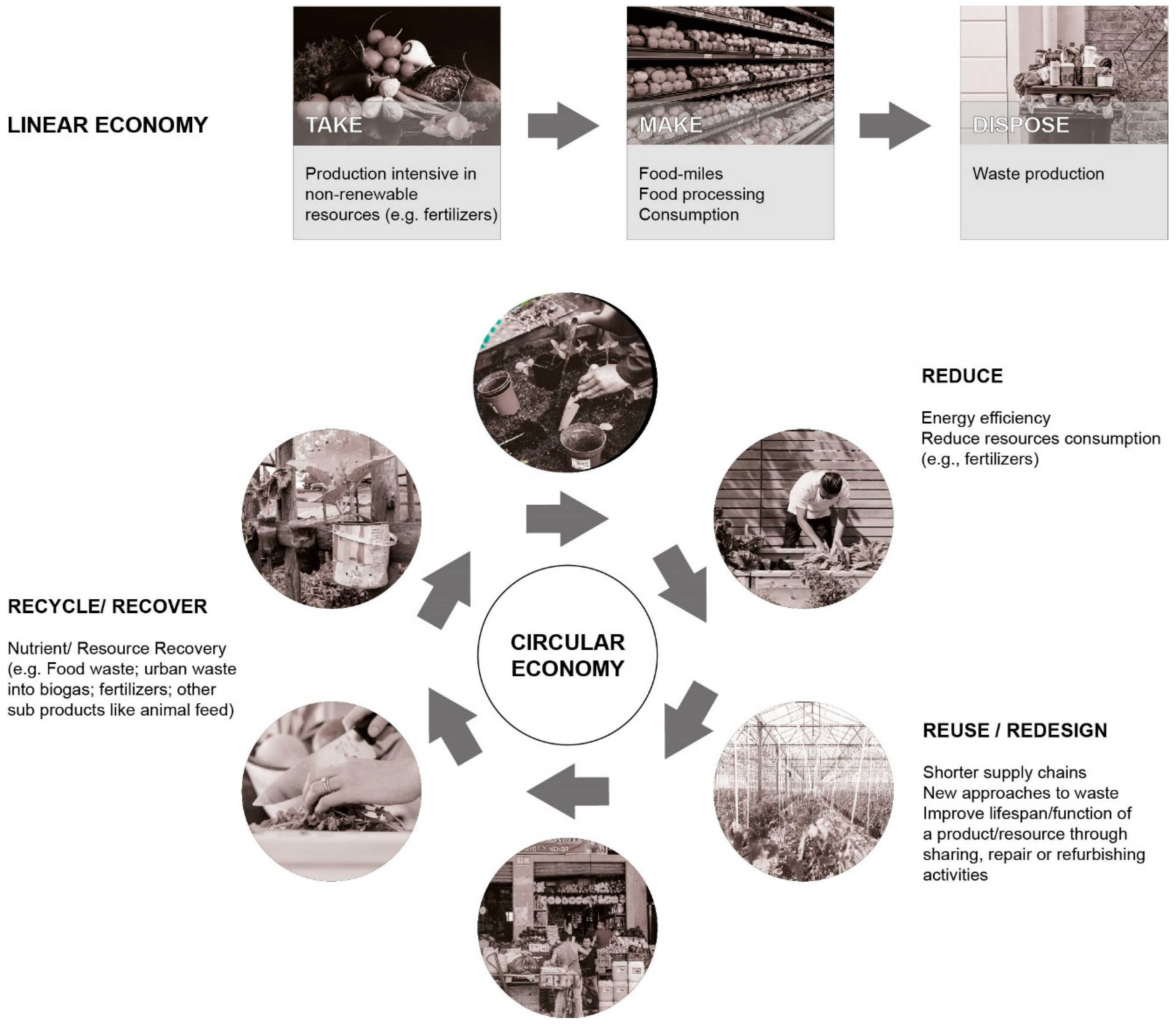

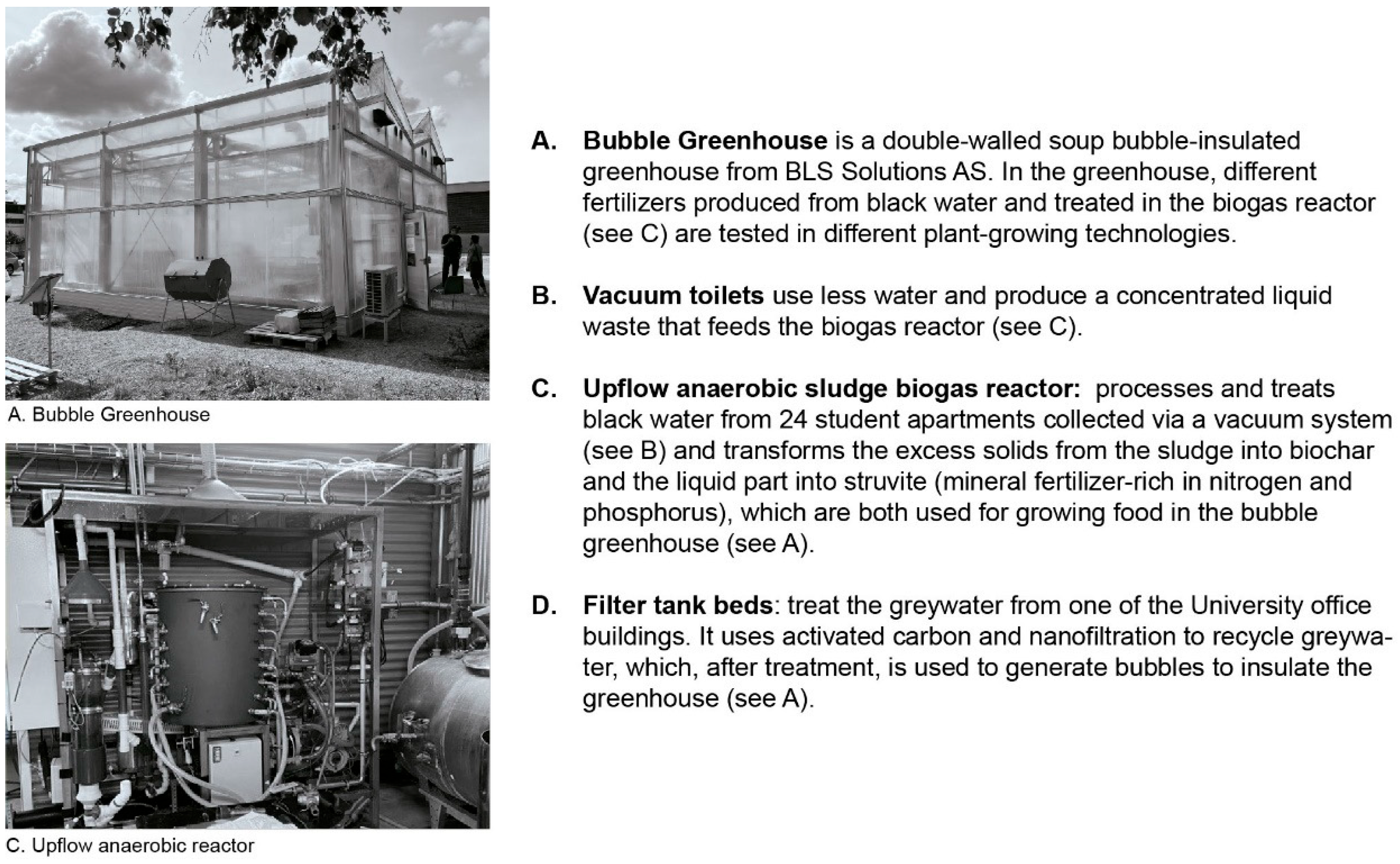
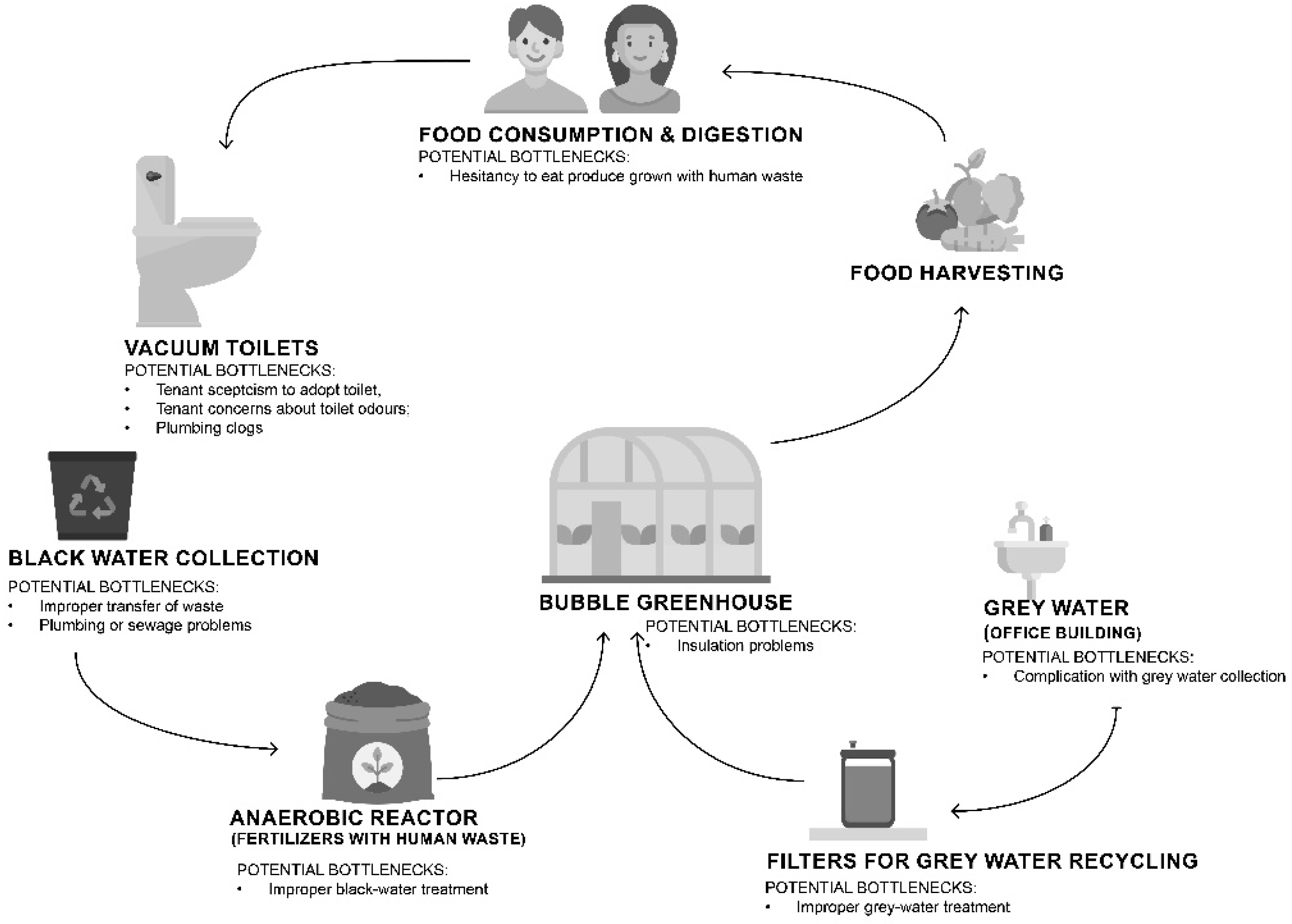
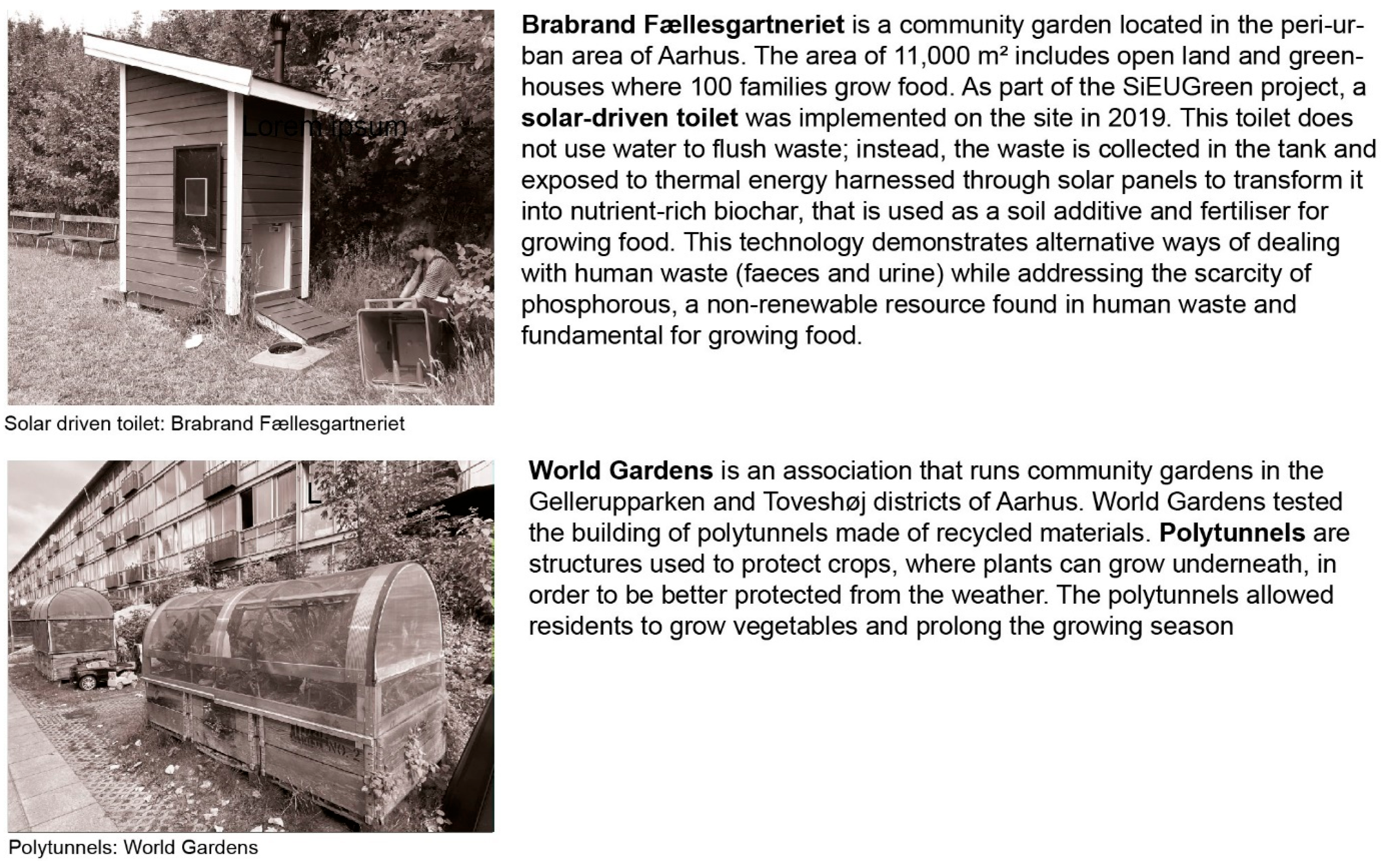

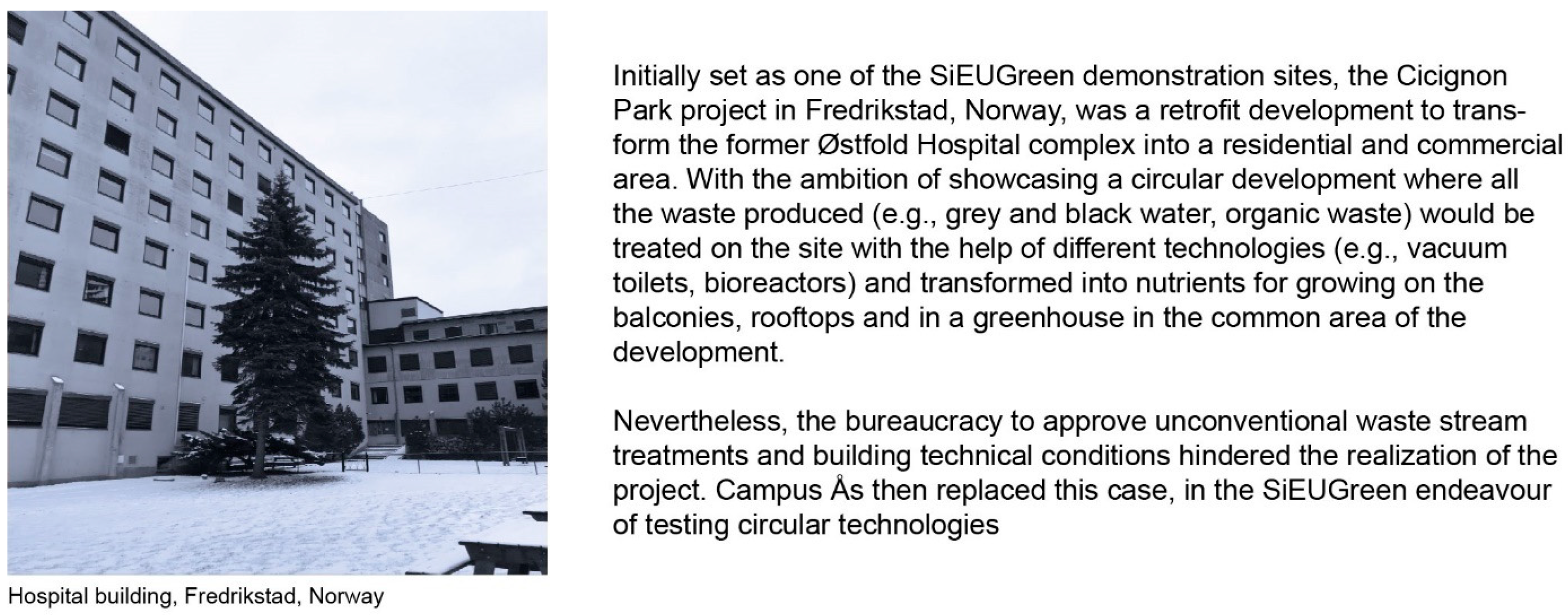
| Case Studies Data Collection | |
|---|---|
| Aarhus (World Gardens and Brabrand Fællesgartneriet—both sites went through the same process) between December 2018 and 2021 | Campus Ås between April 2021 and December 2022 |
| Preliminary interviews before the start of the case studies (2018) | Semi-structured interviews on resource needs for the implementation (April 2021, see Section S4) |
| Semi-structured interviews on resource needs for the implementation (August 2019; see Section S4) | Site visit and interviews to understand main challenges and needs (October 2021) |
| In-person workshop to understand the main challenges and needs (September 2019) | Online follow-up meetings on the implementation and monitoring of the circular processes (three meetings between January 2022 and October 2022; see Section S5) |
| Site visits and interviews to understand the main challenges and needs (September 2019) | In-person follow-up meeting focused on evaluation and lessons learned (November 2022) |
| Online follow-up meetings and e-mail interviews on the implementation and monitoring of the circular processes (three meetings between June 2020 and April 2021, see Section S5) | |
| In-person follow-up meeting focused on evaluation and lessons learned (September 2021) | |
| Barriers | |
|---|---|
| Technical | Related to technology availability and uptake, technological implementation, and technical know-how. |
| Market | Related to financial barriers to innovation, namely high initial costs, asymmetric information, and uncertain return and profit. |
| Institutional | Related to misaligned incentives, regulations mismatches, and inadequate institutional frameworks. |
| Cultural/Social | Related to limited social awareness and literacy concerning urban agriculture and rigidity of consumer behavior. |
| Barriers in UA | Campus Ås | Aarhus |
|---|---|---|
| Technical |
|
|
| Market |
|
|
| Cultural/ Social |
|
|
| Institutional/ Regulatory |
|
|
| C-E Strategy | Impact of Urban Agriculture on Case Studies’ Circularity |
|---|---|
| REDUCE: Input minimization and efficient use of regenerative resources. This strategy focuses on the prevention and reduction of raw materials and energy consumption. |
|
| REUSE: Life-cycle extension and systems reconceptualization. This strategy is related to expanding/optimizing lifespans, re-conceptualizing products to greater lifecycles from the outset, facilitating maintenance, repair, reconditioning, and re-manufacturing options, and creating new business models. |
|
| RECYCLE/RECOVER: Waste reduction, valorization, and minimization. This strategy relates to waste management and recycling of waste that cannot be reused or re-manufactured. It also involves using waste/byproducts from one process as raw materials for another, thereby ascribing a higher value to waste materials as potential resources that can feed production. |
|
Disclaimer/Publisher’s Note: The statements, opinions and data contained in all publications are solely those of the individual author(s) and contributor(s) and not of MDPI and/or the editor(s). MDPI and/or the editor(s) disclaim responsibility for any injury to people or property resulting from any ideas, methods, instructions or products referred to in the content. |
© 2024 by the authors. Licensee MDPI, Basel, Switzerland. This article is an open access article distributed under the terms and conditions of the Creative Commons Attribution (CC BY) license (https://creativecommons.org/licenses/by/4.0/).
Share and Cite
De Jesus, A.; Aguiar Borges, L. Pathways for Cleaner, Greener, Healthier Cities: What Is the Role of Urban Agriculture in the Circular Economy of Two Nordic Cities? Sustainability 2024, 16, 1258. https://doi.org/10.3390/su16031258
De Jesus A, Aguiar Borges L. Pathways for Cleaner, Greener, Healthier Cities: What Is the Role of Urban Agriculture in the Circular Economy of Two Nordic Cities? Sustainability. 2024; 16(3):1258. https://doi.org/10.3390/su16031258
Chicago/Turabian StyleDe Jesus, Ana, and Luciane Aguiar Borges. 2024. "Pathways for Cleaner, Greener, Healthier Cities: What Is the Role of Urban Agriculture in the Circular Economy of Two Nordic Cities?" Sustainability 16, no. 3: 1258. https://doi.org/10.3390/su16031258
APA StyleDe Jesus, A., & Aguiar Borges, L. (2024). Pathways for Cleaner, Greener, Healthier Cities: What Is the Role of Urban Agriculture in the Circular Economy of Two Nordic Cities? Sustainability, 16(3), 1258. https://doi.org/10.3390/su16031258





